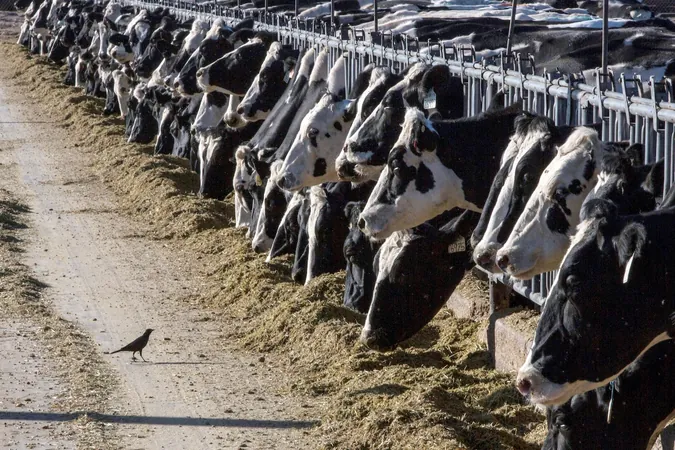
How the Bird Flu Crisis in America Could Lead to a New Pandemic
2024-12-26
Author: Ting
In a shocking revelation at the World Dairy Expo in Wisconsin, livestock veterinarian Keith Poulsen was confronted by farmers who showed him distressing videos of their sick cows, revealing the desperate measures taken to treat them. Cows were being hydrated in complex systems designed to pump large volumes of electrolyte-rich fluids into their esophagi—a sight Poulsen likened to a field hospital on a battlefield.
The Scale of the Outbreak
The scale of the bird flu outbreak, particularly among cattle, has reached alarming levels. It has now affected at least 875 herds across 16 states, raising concerns about the government’s failures to contain the virus when it was confined to a few states. Experts in virology and public health have expressed growing doubt regarding the government's ability to manage this crisis.
Warnings from Experts
"We are heading toward a catastrophic situation," warned Angela Rasmussen, a virologist from the University of Saskatchewan, who highlighted the terrifying prospect of a bird flu pandemic.
Investigation Findings
An investigation by KFF Health News, involving nearly 70 interviews with government officials, farmers, and researchers, uncovered a plethora of issues contributing to the unchecked spread of the virus. Public health responses were delayed and underfunded, and concerns regarding agricultural worker safety were largely overlooked.
Cost of the Outbreak
Alarmingly, the U.S. Department of Agriculture (USDA) only instituted nationwide milk testing this month, a measure that many believe should have been implemented much earlier. Experts noted a disturbing trend of repeating mistakes from the COVID-19 crisis, with slow responses to emerging threats.
Financial Impact on Dairy Industry
The USDA has already invested over $1.7 billion to mitigate the bird flu's impact on poultry farms, but the costs of this outbreak on the dairy industry alone could reach billions more, with infected cows leading to a 20% decrease in milk production and a mortality rate of 2-5%.
Human Infection Concerns
The human toll is not just a hypothetical concern. While only about 60 people have been infected so far, these cases have largely resulted from contact with infected cattle or poultry. A recent case in Louisiana highlighted the serious ramifications of the virus, prompting fears that even a few mutations could enable the virus to spread more easily among humans.
Urgency in Addressing the Threat
Researchers like Tom Peacock have underscored the urgency of addressing this threat, stating, "Even a 5% chance of a pandemic represents a dire scenario."
Origin of the Outbreak
The outbreak began in Texas, where farmers noticed a drastic decline in milk production. Upon investigation, the pathogen was identified as the highly pathogenic H5N1 bird flu virus—a variant infamous for its potential to cause pandemics.
Federal Response Issues
Subsequent federal intervention failed to involve farmers and veterinarians adequately, leading to miscommunication and ineffective measures that allowed the virus to spread largely unchecked.
Impact on Workers
As outbreaks transitioned from dairy farms to poultry operations, workers, many of whom lacked proper protections, were thrown into hazardous situations. Reports indicated that infected workers were exhibiting severe symptoms, yet safety measures and testing protocols were alarmingly absent.
The Dilemma for Public Health Departments
Public health departments found themselves trapped between the urgency of the agricultural community and the constraints imposed by farmers who resisted government interventions, fearing economic backlash and loss of milk markets.
Barriers to Seeking Care
Many agricultural workers refrained from seeking medical attention due to concerns about repercussions from their employers or the high costs of healthcare.
Preparedness for Future Pandemics
The CDC and USDA’s approach to managing this crisis has raised questions about their preparedness for future pandemics. With each passing day, the risk of this virus evolving into a more contagious form looms larger.
Calls for Enhanced Surveillance
Maria Van Kerkhove from WHO expressed grave concerns, noting that failures in controlling this outbreak could set a precedent for future pathogens that might emerge.
Challenges in Winter
As we enter winter, respiratory illnesses become more challenging to manage due to overlapping symptoms with seasonal flu, raising the specter of mixed infections.
Risk of a New Hybrid Strain
If the bird flu manages to swap genes with other influenza viruses, it could lead to a new hybrid strain that spreads rapidly among human populations.
Urgent Recommendations
In an urgent call to action, experts recommend comprehensive testing and surveillance not only for infected farms but also within communities heavily populated by agricultural workers. Enhancements in outreach and funding for worker health are paramount to prevent a broader public health crisis.
Future Strategies
The USDA is being urged to expand its strategies to include thorough and regular testing of bulk milk and to provide access to vaccines for farmworkers, ensuring that measures are in place to safeguard both animal and human health.
Conclusion
The viral situation is dire, and proactive efforts are necessary. The agricultural community recognizes that without change in practices and policies, we risk a repeat of history—a pandemic fueled by a virus they could have contained. Responses today will determine the future, as farmers, veterinarians, and public health officials come together in a fight against an unseen enemy.

 Brasil (PT)
Brasil (PT)
 Canada (EN)
Canada (EN)
 Chile (ES)
Chile (ES)
 España (ES)
España (ES)
 France (FR)
France (FR)
 Hong Kong (EN)
Hong Kong (EN)
 Italia (IT)
Italia (IT)
 日本 (JA)
日本 (JA)
 Magyarország (HU)
Magyarország (HU)
 Norge (NO)
Norge (NO)
 Polska (PL)
Polska (PL)
 Schweiz (DE)
Schweiz (DE)
 Singapore (EN)
Singapore (EN)
 Sverige (SV)
Sverige (SV)
 Suomi (FI)
Suomi (FI)
 Türkiye (TR)
Türkiye (TR)